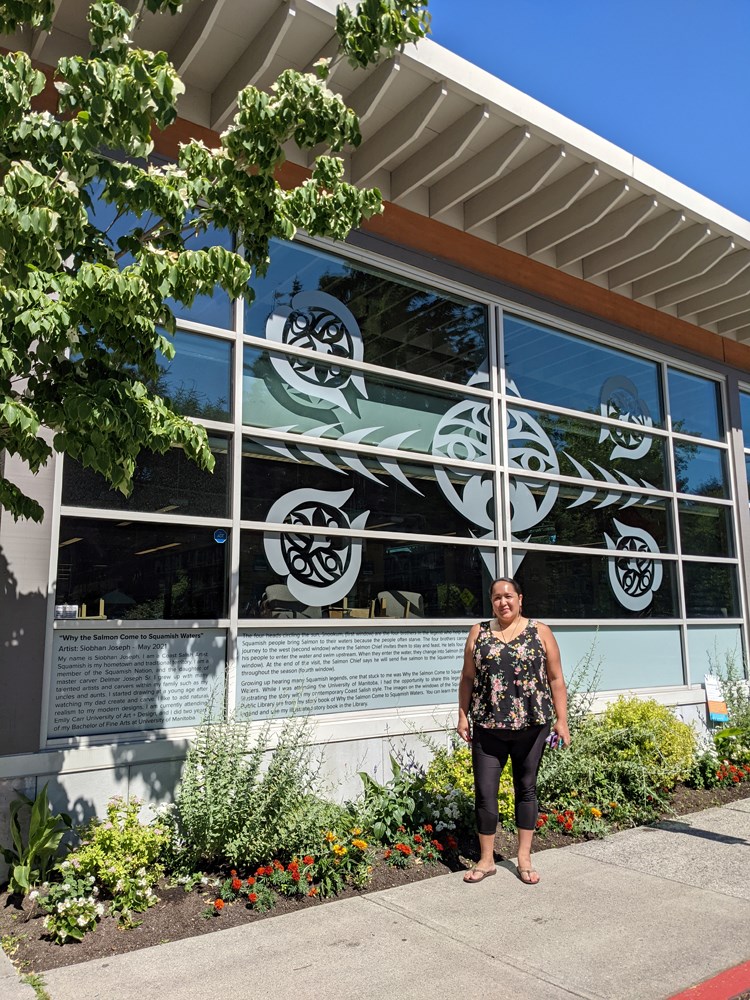Siobhan Joseph not only grew up surrounded by artists, but the legends of her Squamish Nation. As she listened to her aunties and uncles and elders sharing these stories, like any good artist, she couldn’t help but visualize them coming to life in her mind’s eye.
“I would think of a picture in my mind and then I would put them on paper,” Joseph said. “I’m a self-taught artist, just picking up from what was around me.”
And what was around the 39-year-old was a plethora of talent and skill. The daughter of master carver Delmar Joseph Sr., practically each of her nine uncles is an accomplished carver and artist in his own right.
“My dad was so busy carving, just providing for the family, and my way of spending time with him was sitting around watching him carve. Then as I got older, I’d steal his acrylic paints and start painting,” Joseph said.
Now Joseph has the chance to carry on her family and community’s legacy with a new art installation in the Squamish Public Library that depicts the Squamish legend, “Why the Salmon Come to Squamish Waters.” A large-scale wrap on the library’s front windows facing Second Avenue and the north-side windows facing municipal hall, the original work was selected from the library’s call for artists last fall.
For Joseph, who incorporated designs from a children’s book she made while at the University of Manitoba in Winnipeg — the library also has some copies of the book available — continuing on the teachings of her Nation through her distinct, contemporary take on Coast Salish art is an essential component of her work.
“I’m honoured to share this with my children and to carry on this legacy,” Joseph said. “I think it’s very important to share our legends and to keep those stories going and make sure that our children know our legends, because they have a lot of meaning and teachings and we show some of our customs through it.”
The legends speaks of a time when humans and animals were the same, and four brothers who went about doing good came to the Squamish People’s village, when the chief asked them if they could bring salmon to their shores. The brothers agreed, and went on the search for the Salmon People. Heading on the long journey west, the brothers got the villagers to follow behind in their canoes, paddling for days until they reached an island village, home of the Salmon People.
Once there, they offered herbs and medicine to the village’s Salmon Chief, who, in gratitude, told the four brothers to swim up the creek to a waiting fish trap. As soon as the water reached their faces, they transformed into salmon. Later, after four days of feasts, the eldest brother explained to the village chief why they had come, to request that he allow some of his Salmon People travel upstream to the Squamish. The chief agreed, on one condition: that they promise to throw all the salmon bones back into the water, as they had watched his people do. The brothers and Squamish People agreed. As they were leaving, the chief told his guests that he would send spring salmon to them first in the season, then sockeye, then coho, then the chum, and last of all, the humpback. Ever since, the different salmon have reached Squamish waters every season, in that order.
“I think it’s one of my favourite legends,” Joseph said. “It’s our custom that when you take something from the water, you bring it back and it will help bring back more salmon.”
Joseph is one of only a handful of Squamish artists working to revive the traditions of Coast Salish art. Currently enrolled at the Emily Carr University of Art + Design, Joseph said she has been working in a variety of mediums, but no matter the style, she always finds a way to incorporate Coast Salish designs.
“I tell people that Coast Salish art is a revival art because not many people do it,” she explained. “A lot of artists don’t practise the traditional Coast Salish art because of colonialism and the Indian Act, [which meant] we weren’t allowed to practise our ceremonies or anything. My grandparents had to hide some of their masks… and couldn’t do art. A lot of that is lost.”



